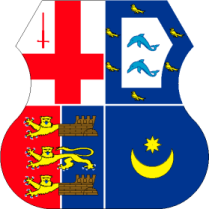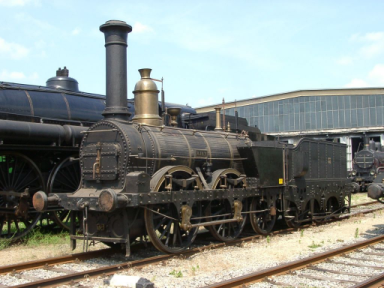 |
 |
 |
 |
 |
 |
 |
|
The London, Brighton and South Coast Railway
I aim to keep this short. I'm not a historian, or even an expert on this particular railway. There are many people with both resources and knowledge on the subject. Perhaps now there are few with first hand knowledge. I simply feel that in support of the drawings I am beginning to produce, I should also produce some information about the railway on which it ran, and in later pages the designer of the locomotive. The coat of arms on the right is that of the LBSCR. In fact, the real thing depicts the dragons that feature on the London coat of arms, and includes gold leaf, and exquisite artwork. The sections from left to right, and top to bottom, depict;
The coat of arms here doesn't do the real thing justice at all. The real thing can be seen at stations in London, and around Sussex, but time tends to fade the beauty. To see a recent rendering, check out the directors saloon page, at the Bluebell Railway. It's likely to be a while before the carriage is restored but perhaps with the HLF award and maybe even your donations, it can be sooner rather than later. For more detailed information and contacts on the LBSCR, check out the link here. The LBSCR was a railway company formed in 1846, by Act of Parliament, out of;
The london connectionBy 1847 the LBSCR railway network covered a large part of the Sussex coast, with a focal point at the capital, London. Initially the main LBSCR terminus in London was London Bridge, in a shared arrangement with the involved parties. The London Bridge terminus was actually owned by the London and Greenwich Railway, and the South Eastern Railway had been paying a princely sum as rent for the use of London Bridge station. Together the London and Croydon and South Eastern ralways obtained Royal Assent in 1843 to build a new terminus and a connection to it, south of London Bridge. Bricklayers Arms served well as a means for both railways to reduce operating costs. It gave them a way to operate in London without having to use London Bridge, and pay the London and Greenwich railway for the benefit. In practice Bricklayers arms was an inconvenient choice for passengers wanting to get to the city, and in the end it became a goods and engineering facility for the railways. The LBSCR inherited this way of working into London when created out of the London and Croydon railway. By 1849 the LBSCR had built their own route into London Bridge. In 1860 the LBSCR and the Chatham and Dover Railways together opened a shared terminus in London's West End, Victoria. London to BrightonThe idea of a railway connecting London and Brighton surfaced as early as 1823, some seven years prior to the completion ofthe Liverpool and Manchester Railway, the first inter-city railway. The proposals must have been made at similar times, but not until 1837 was an Act of Parliament passed to make the London and Brighton railway possible. Amongst the proposals, two routes were considered. The chosen route through Redhill and Haywards Heath, was more direct, but more expensive, presumably because of the necassary viaduct at Balcombe, and the long tunnels there and to the south. The alternative route was Dorking, Horsham, Shoreham, some ten miles to the west of the chosen route. Time would see both routes developed, but it would also seem that Parliament made the correct choice. The Steyning/Adur valley line was axed by Dr Beeching in 1966 through lack of use. The civil engineer for the project to develop the London and Brighton Railway was John Urpeth Rastrick, and along with the chief architect, David Mocatta, they built a railway starting in 1838. It is suggested that some 6000 men, 1000 horses, 5 locomotives and 7 stationary engines were used to drive the railway through the countryside. Rastrick had some task on his hands, even by moden standards. Five serious tunnels had to be built, at Merstham, Balcome, Haywards Heath, Patcham and Clayton, two of which were in excess of a mile in length. In addition, a 100ft high viaduct 1/3 of a mile in length between Balcombe and Haywards Heath. The picture below (kindly reproduced from wikipedia), gives a sense of scale as the Viaduct passes majestically over the Borde Hill Estate. Bear in mind that the viaduct is relatively small by comparison with some of the cuttings and tunnels which they had to produce.  In those early days they had very little equipment to help them. They would have had rudimentary explosives, although it would not be until 1867 that Alfred Nobel would demonstrate the first use of dynamite, in a quarry less than a mile from the path of the railway. They had very little in the way of mechanical handling equipment. Today we think alot of perhaps a couple of hundred, in a extreme case a thousand, people working on a big civil project. They mostly work in offices. This was six thousand people and the majority only had a pick axe. The remainder looked after the horses. The picture below (kindly reproduced from Dieter Zoubek) shows a typical example of the five locomotives that would have been available to those building the railway. I think you'll agree it was pretty primitive.  The first servicesBy the end of 1841, the the line was completed, and given that by 1846 the initial investors in the railway were unhappy with the return on their investment, it seems reasonable to assume that the first services were somewhat chaotic. Although the Canterbury and Whitstable railway was the first modern railway, Witstable is quite small, and the demand would never have been that of an inter-city railway. The distance between termini of the Liverpool and Manchester Railway was only 30 miles. On the Brighton line services seem to have run on the basis of pooled locomotives and presumably rolling stock. At the time the pool would have been configured for the very early days of a small suburban railway. People really did want to travel between London and Brighton, like Liverpool and Manchester. Suddenly they faced a big demand on the Brighton line, but with a 75 mile journey. It's quite likely that to start with they only had open passenger wagons. Even the locomotives were somewhat removed from being ideal for their task.The locomotive manufacturers were overwhelmed with work. Track problems were encountered on the Liverpool and Manchester line and these were also encountered on the Canterbury and Whitstable. The North Midland Railway, another inter-city route of similar length, had followed a similarly difficult route through the countryside, and similar levels of investment were necassary. The Hull and Selby line was another short line like the Liverpool and Manchester. The raw newness of passenger railway technology would have made it's viability seem like a questionable novelty that perhaps could not translate into a meaningful benefit to society. It is easily possible to believe that the investors felt that the North Midland and Brighton line civil engineering works were a massive massive white elephant. I can almost smell their fear. The railway bubble burst, left an investment gap, and undoubtedly a big headache for the LBSCR. The first locomotive superintendent at the LBSCR was one John Gray. Gray had come from the Hull and Selby Railway as an innovative early pioneer. Irrespective of his personal capability, the engineering infrastructure of the nation was not up to the demand being placed by all the new railways. He was unable to obtain much needed locomotive stock and was dismissed. Gray was followed by Thomas Kirtley, formerly an engine driver on the Liverpool and Manchester railway. Kirtley set up a locomotive building company in 1837, but it failed in 1841. He worked for many of the emerging railway companies until securing the job of locomotive superintendent at the LBSCR. Sadly, within nine months Kirtley died of a brain tumor. In 1847 John Chester Craven had taken the superintendent role, and would be the first engineer to have an impact on the pervasive problems of obtaining stock and locomotives to form up trains, move people, and make money. The Craven EraIt is often cited that Craven was something less than perfect because of his motley collection of locomotives, and his refusal to standardise. Certainly it is quite difficult to make an accurate assesment for ones self, simply because the technology of photography hadn't really become available at that point. I think he should be given more leeway than he generally receives. This is simply because he must have been under some considerable pressure to perform faultlessly. We must remember that this was an environment where most people didn't know for sure what the best next move actually was. If Brunel himself can make the mistake of mandating broad gauge, I think Craven should get some space not to believe in standardisation. In practice, Craven did standardise many aspects of the operation of the LBSCR. He fixed the primary site of works in Brighton, by the station, and he also built up the necassary facilities such that the LBSCR could build their own designs of locomotives. It is actually possible to gauge the demand on the LBSCR for new locomotives. Despite having and using their new locomotive works at Brighton, it was still necassary to have locomotives manufactured by outside contractors, just to to meet demand. It is difficult to think that any of the other new railways were any different. In this environment then, it is understandable that the the outside contrctors wanted to build long runs of similar locomotives for other railway companies. It would often be the case that the actual designs manufactured were not those desired by the individual railway companies, and these would not necassarily be suited to the local working conditions. Craven would, then, have had a difficult task. I can fully image the LBSCR directors giving him a very loose brief to simply procure locomotives and stock, to get the job done and keep the shareholders happy. By 1869, Craven had collected some 200 locomotives, in many different types. For the directors, this was no longer satisfactory, the priorities had changed. Availability, and the ability to choose locomotive types, had improved for the LBSCR, and they no longer felt that the policy that Craven had implemented was satisfactory. Having to maintain such a wide variety of locomotives, and in such great numbers was no longer cost effective. Craven had made the railway work in a difficult environment, although not without expense. In 1866 the LBSCR was facing bankruptcy, presumably because of the finance gap induced by the bursting railway investment bubble. Although the directors by this time knew they had a winning formula with their railway, they badly needed to cut costs, and expand their operation to climb out of their financial hole. Significant expansion had already occured, but due to constraints, only in a limited way. History records that the LBSCR began to construct the "Bluebell" and "Cuckoo" Lines, just ten years later, and these ideas must have been on their minds. The only way the directors would have been able to attain these expansionist goals without the same level of original investment would be to make the railway more efficient, and use improved profits to expand. Unfortunately for Craven, who I would imagine saw his dilligent work as unfinished, there was a mismatch of outlook. Craven resigned his post as locomotive superintendent in 1869. Craven was replaced by William Stroudley, and because of his relationship to Gladstone (the locomotive), the next pages are devoted to Stroudley and that particular locomotive. |
Copyright © Solid Fluid 2007-2025 |
Last modified: SolFlu Thu, 23 Dec 2010 13:32:44 GMT |